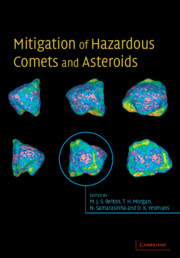Book contents
- Frontmatter
- Contents
- List of contributors
- Preface
- Acknowledgments
- Glossary
- 1 Recent progress in interpreting the nature of the near-Earth object population
- 2 Earth impactors: orbital characteristics and warning times
- 3 The role of radar in predicting and preventing asteroid and comet collisions with Earth
- 4 Interior structures for asteroids and cometary nuclei
- 5 What we know and don't know about surfaces of potentially hazardous small bodies
- 6 About deflecting asteroids and comets
- 7 Scientific requirements for understanding the near-Earth asteroid population
- 8 Physical properties of comets and asteroids inferred from fireball observations
- 9 Mitigation technologies and their requirements
- 10 Peering inside near-Earth objects with radio tomography
- 11 Seismological investigation of asteroid and comet interiors
- 12 Lander and penetrator science for near-Earth object mitigation studies
- 13 Optimal interception and deflection of Earth-approaching asteroids using low-thrust electric propulsion
- 14 Close proximity operations at small bodies: orbiting, hovering, and hopping
- 15 Mission operations in low-gravity regolith and dust
- 16 Impacts and the public: communicating the nature of the impact hazard
- 17 Towards a national program to remove the threat of hazardous NEOs
- Index
9 - Mitigation technologies and their requirements
Published online by Cambridge University Press: 12 October 2009
- Frontmatter
- Contents
- List of contributors
- Preface
- Acknowledgments
- Glossary
- 1 Recent progress in interpreting the nature of the near-Earth object population
- 2 Earth impactors: orbital characteristics and warning times
- 3 The role of radar in predicting and preventing asteroid and comet collisions with Earth
- 4 Interior structures for asteroids and cometary nuclei
- 5 What we know and don't know about surfaces of potentially hazardous small bodies
- 6 About deflecting asteroids and comets
- 7 Scientific requirements for understanding the near-Earth asteroid population
- 8 Physical properties of comets and asteroids inferred from fireball observations
- 9 Mitigation technologies and their requirements
- 10 Peering inside near-Earth objects with radio tomography
- 11 Seismological investigation of asteroid and comet interiors
- 12 Lander and penetrator science for near-Earth object mitigation studies
- 13 Optimal interception and deflection of Earth-approaching asteroids using low-thrust electric propulsion
- 14 Close proximity operations at small bodies: orbiting, hovering, and hopping
- 15 Mission operations in low-gravity regolith and dust
- 16 Impacts and the public: communicating the nature of the impact hazard
- 17 Towards a national program to remove the threat of hazardous NEOs
- Index
Summary
Protection of the Earth from undesirable impacting bodies is not just a science fiction project for some improbable future. The cost might be comparable to, even smaller than, the world's current military expenditures. We could choose to do it now. We could choose to protect ourselves from asteroids and comets rather than from each other.
Fred L. Whipple, The Mystery of Comets, 1985Introduction
Impacts of near-Earth objects (NEOs) onto our planet are natural events where the effects of each single impact mainly depend on NEO size, structure, relative velocity, and impact location. To determine if a newly discovered object might impact on Earth one day, the object's orbit has to be numerically computed into the future. The accuracy of this orbit prediction basically depends on the optical and eventually radar measurements available for that object, and of course on the completeness and precision of the numerical perturbation models. Care has to be taken when handling few observations, long prediction periods, and unendorsed NEO properties, which might lead to large uncertainties in collision probability prediction (e.g., Giorgini et al. 2002).
NEOs larger than 150 m in diameter and approaching Earth's orbit closer than 7.5 million km (0.05 AU) are called Potentially Hazardous Objects (PHOs). Due to their susceptibility to small orbit disturbances on short timescales they are candidates for future collisions with Earth. Typical near-Earth asteroid (NEA) impact velocities onto the Earth range from 11.18 to about 25 km s–1, whereas comets typically impact at higher velocities up to 73.65 km s–1 if on a retrograde orbit (e.g., Gritzner 1996).
Information
- Type
- Chapter
- Information
- Mitigation of Hazardous Comets and Asteroids , pp. 167 - 200Publisher: Cambridge University PressPrint publication year: 2004
Accessibility standard: Unknown
Why this information is here
This section outlines the accessibility features of this content - including support for screen readers, full keyboard navigation and high-contrast display options. This may not be relevant for you.Accessibility Information
- 8
- Cited by
